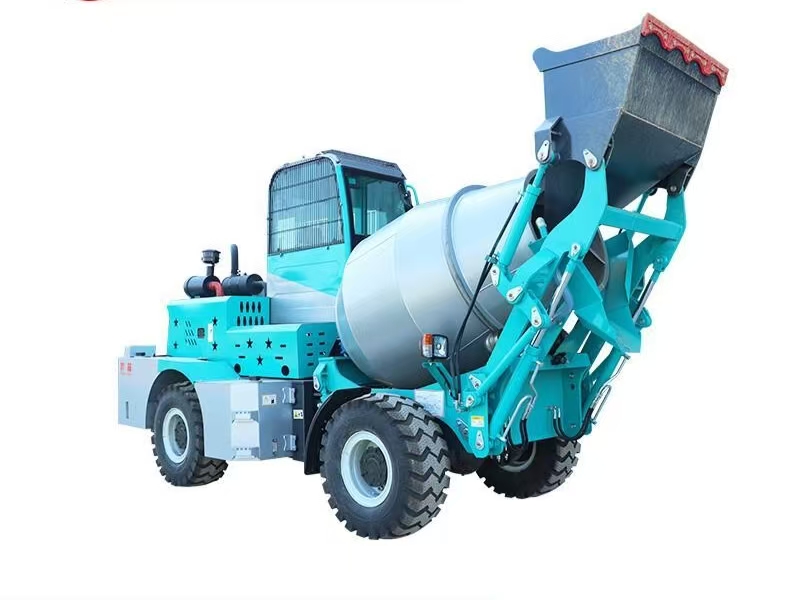The self-loading concrete mixer is an engineering machinery equipment that integrates the functions of concrete mixing and transportation. The following will introduce it from aspects such as its working principle, types, characteristics, application scenarios and purchasing points:

Working Principle
- Power Transmission: Power is obtained from the automobile chassis through a power take-off device to drive the variable pump of the hydraulic system, converting mechanical energy into hydraulic energy. Then the hydraulic energy drives the fixed-displacement motor, which drives the reducer, and finally the reducer drives the mixing device to mix the concrete.
- Loading Process: Using the vehicle's own loading device, such as a bucket or conveyor belt, raw materials such as sand, gravel and cement are loaded into the mixing tank from the stockpile or silo. Some self-loading mixers are also equipped with an automatic weighing system, which can accurately control the input amount of various raw materials.
- Mixing Process: The mixing tank rotates continuously while driving or at a fixed position. The mixing blades inside the tank fully stir the raw materials, so that cement, sand, gravel, water, etc. are evenly mixed to form concrete that meets the requirements.
- Unloading Process: After arriving at the construction site, the mixing tank is controlled to tilt through the hydraulic system, and the concrete is unloaded from the mixing tank to the designated construction position.
Types
- Classified by Travel Mode
- Tire-type: It is flexible in movement, convenient for transferring between sites, can drive on ordinary roads, and is suitable for projects that need to be frequently transferred between different construction sites, such as urban road construction, small-scale construction projects, etc.
- Crawler-type: It has good off-road performance and stability, and can adapt to various complex terrains, such as mountainous areas, wetlands, rough roads, etc. However, its moving speed is relatively slow, and the cost of transferring is high. It is often used in large-scale infrastructure construction, mining projects, etc.
- Classified by Mixing Mode
- Gravity-type: Blades are installed on the inner wall of the mixing drum. When the mixing drum rotates, the blades lift the materials to a certain height, and then the materials fall freely under the action of gravity. This is repeated to stir the materials. This mixing method is suitable for mixing plastic concrete and low-fluidity concrete.
- Forced-type: There is a rotating mixing shaft in the mixing drum, and mixing blades are installed on the shaft. The materials are forced to be stirred by the mixing blades, so that the materials can be evenly mixed in a short time. The forced mixing method is suitable for mixing dry-hard concrete, high-strength concrete and lightweight aggregate concrete, etc.
Characteristics
- High Degree of Automation: It automatically completes a series of operations such as loading, mixing, transportation and unloading, reducing manual intervention, lowering labor intensity and improving construction efficiency.
- Multi-functional Integration: It integrates multiple functions such as loading, mixing, transportation and unloading, without the need for additional loaders, mixers and transport vehicles, reducing equipment investment and site occupation.
- Strong Flexibility: It has a relatively small volume and a small turning radius, and can work in narrow construction sites and complex terrain conditions, especially suitable for small construction sites or engineering construction in remote areas.
- Energy-saving and Environmental Protection: It adopts advanced hydraulic system and engine technology, with low energy consumption and high efficiency. At the same time, the closed mixing tank design reduces concrete leakage and dust pollution, meeting environmental protection requirements.
Application Scenarios
- Construction Sites: Used for pouring concrete structural components such as foundations, walls, floor slabs and columns.
- Road Construction: Can be used for road paving, bridge construction, culvert construction and other road projects.
- Rural Construction: Plays an important role in small-scale projects such as rural farmland water conservancy construction, rural road construction, and house building.
- Mining Engineering: Suitable for mining road construction, mining infrastructure construction and tailings treatment, etc.
Purchasing Points
- Choose the Model According to Engineering Needs: Small self-loading mixers are suitable for small-scale projects, and large ones are suitable for large-scale construction.
- Pay Attention to Vehicle Performance: Including mixing tank capacity, engine power, stability of the hydraulic system, loading speed, mixing uniformity, unloading speed, etc.
- Consider After-sales Service: Choose brands and manufacturers with a sound after-sales service network to ensure that the vehicle can receive timely maintenance and repair during use, and that spare parts are fully supplied.
- Budget and Cost-effectiveness: On the premise of meeting engineering needs, comprehensively consider factors such as equipment price, performance, quality and after-sales service, and choose products with high cost-effectiveness.





